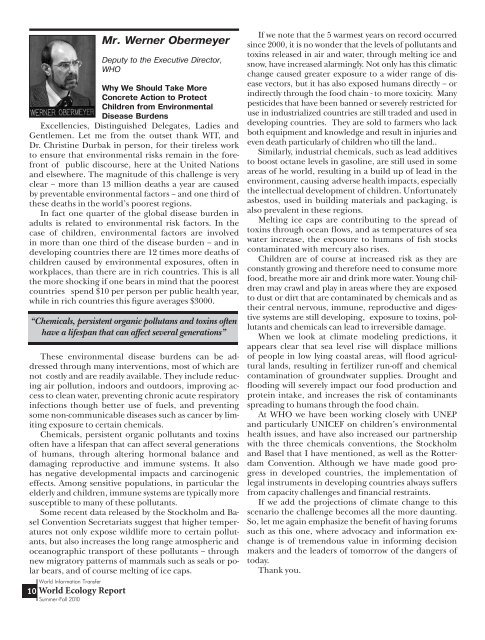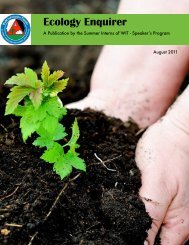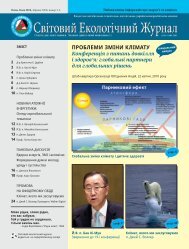V. XXII No 2, 3 - World Information Transfer
V. XXII No 2, 3 - World Information Transfer
V. XXII No 2, 3 - World Information Transfer
Create successful ePaper yourself
Turn your PDF publications into a flip-book with our unique Google optimized e-Paper software.
<strong>World</strong> <strong>Information</strong> <strong>Transfer</strong>10 <strong>World</strong> Ecology ReportSummer-Fall 2010Mr. Werner ObermeyerDeputy to the Executive Director,WHOWhy We Should Take MoreConcrete Action to ProtectChildren from EnvironmentalDisease BurdensExcellencies, Distinguished Delegates, Ladies andGentlemen. Let me from the outset thank WIT, andDr. Christine Durbak in person, for their tireless workto ensure that environmental risks remain in the forefrontof public discourse, here at the United Nationsand elsewhere. The magnitude of this challenge is veryclear – more than 13 million deaths a year are causedby preventable environmental factors – and one third ofthese deaths in the world’s poorest regions.In fact one quarter of the global disease burden inadults is related to environmental risk factors. In thecase of children, environmental factors are involvedin more than one third of the disease burden – and indeveloping countries there are 12 times more deaths ofchildren caused by environmental exposures, often inworkplaces, than there are in rich countries. This is allthe more shocking if one bears in mind that the poorestcountries spend $10 per person per public health year,while in rich countries this figure averages $3000.“Chemicals, persistent organic pollutans and toxins oftenhave a lifespan that can affect several generations”These environmental disease burdens can be addressedthrough many interventions, most of which arenot costly and are readily available. They include reducingair pollution, indoors and outdoors, improving accessto clean water, preventing chronic acute respiratoryinfections though better use of fuels, and preventingsome non-communicable diseases such as cancer by limitingexposure to certain chemicals.Chemicals, persistent organic pollutants and toxinsoften have a lifespan that can affect several generationsof humans, through altering hormonal balance anddamaging reproductive and immune systems. It alsohas negative developmental impacts and carcinogeniceffects. Among sensitive populations, in particular theelderly and children, immune systems are typically moresusceptible to many of these pollutants.Some recent data released by the Stockholm and BaselConvention Secretariats suggest that higher temperaturesnot only expose wildlife more to certain pollutants,but also increases the long range atmospheric andoceanographic transport of these pollutants – throughnew migratory patterns of mammals such as seals or polarbears, and of course melting of ice caps.If we note that the 5 warmest years on record occurredsince 2000, it is no wonder that the levels of pollutants andtoxins released in air and water, through melting ice andsnow, have increased alarmingly. <strong>No</strong>t only has this climaticchange caused greater exposure to a wider range of diseasevectors, but it has also exposed humans directly – orindirectly through the food chain - to more toxicity. Manypesticides that have been banned or severely restricted foruse in industrialized countries are still traded and used indeveloping countries. They are sold to farmers who lackboth equipment and knowledge and result in injuries andeven death particularly of children who till the land..Similarly, industrial chemicals, such as lead additivesto boost octane levels in gasoline, are still used in someareas of he world, resulting in a build up of lead in theenvironment, causing adverse health impacts, especiallythe intellectual development of children. Unfortunatelyasbestos, used in building materials and packaging, isalso prevalent in these regions.Melting ice caps are contributing to the spread oftoxins through ocean flows, and as temperatures of seawater increase, the exposure to humans of fish stockscontaminated with mercury also rises.Children are of course at increased risk as they areconstantly growing and therefore need to consume morefood, breathe more air and drink more water. Young childrenmay crawl and play in areas where they are exposedto dust or dirt that are contaminated by chemicals and astheir central nervous, immune, reproductive and digestivesystems are still developing, exposure to toxins, pollutantsand chemicals can lead to irreversible damage.When we look at climate modeling predictions, itappears clear that sea level rise will displace millionsof people in low lying coastal areas, will flood agriculturallands, resulting in fertilizer run-off and chemicalcontamination of groundwater supplies. Drought andflooding will severely impact our food production andprotein intake, and increases the risk of contaminantsspreading to humans through the food chain.At WHO we have been working closely with UNEPand particularly UNICEF on children’s environmentalhealth issues, and have also increased our partnershipwith the three chemicals conventions, the Stockholmand Basel that I have mentioned, as well as the RotterdamConvention. Although we have made good progressin developed countries, the implementation oflegal instruments in developing countries always suffersfrom capacity challenges and financial restraints.If we add the projections of climate change to thisscenario the challenge becomes all the more daunting.So, let me again emphasize the benefit of having forumssuch as this one, where advocacy and information exchangeis of tremendous value in informing decisionmakers and the leaders of tomorrow of the dangers oftoday.Thank you.




